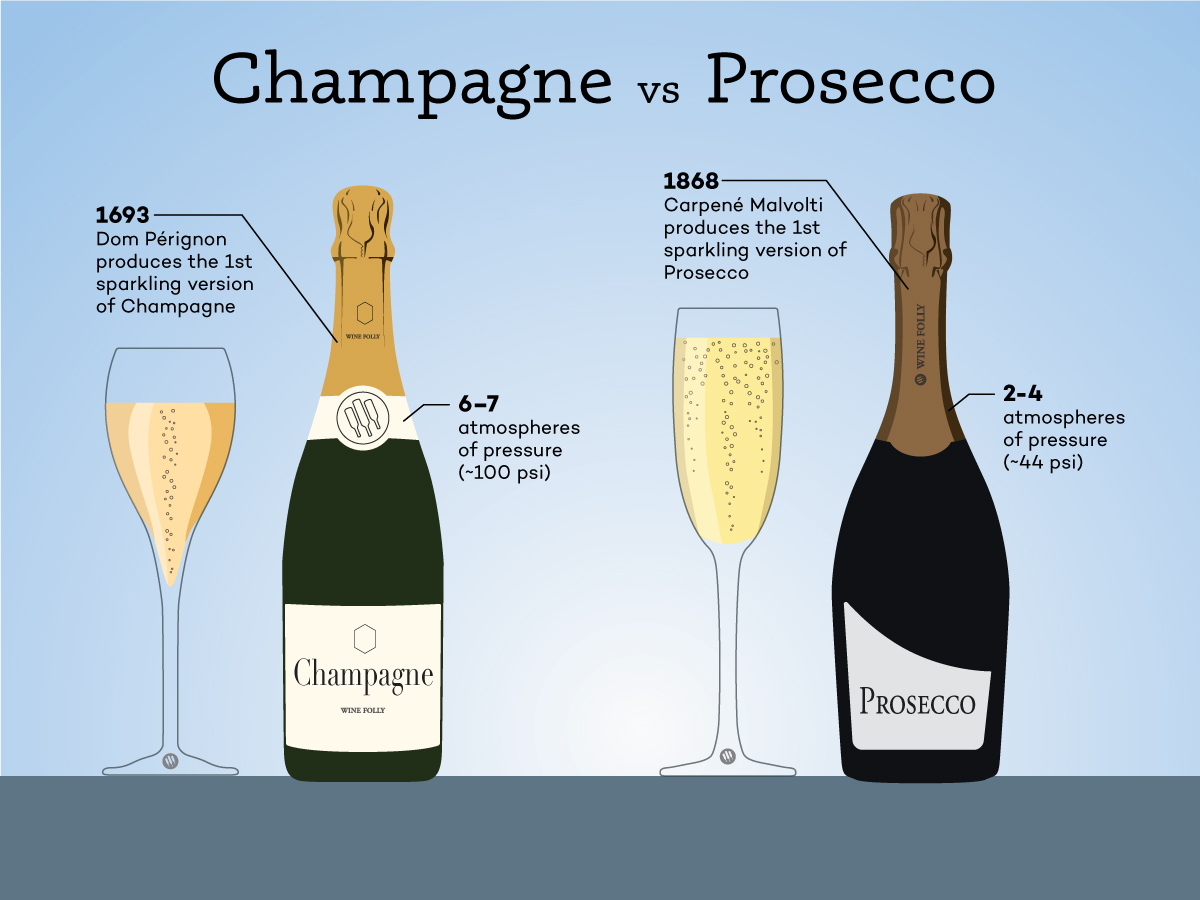
When it comes to celebratory bubbles and raising a toast to life's special moments, Champagne and Prosecco are two names that shine brilliantly on the global stage. These sparkling delights have carved their own unique paths through history, culture, and palate preferences, captivating wine enthusiasts with their effervescence and charm. In this exploration, we embark on a journey to unravel the nuances that set Champagne and Prosecco apart, transcending beyond mere fizzy drinks to embody the essence of celebration. As we delve into the depths of these sparkling wines, we'll uncover the distinct production methods, regional influences, flavor profiles, and ideal occasions for each.
So, whether you're looking to infuse an extra touch of elegance into your soirées or seeking a casual companion for your weekend gatherings, join us as we navigate through the differences between Champagne and Prosecco. Don't forget to check out our recommendations at the end!
Click Here for our HUGE Prosecco Sale (UP TO 58% OFF)
Are Prosecco and Champagne the same?
Prosecco and Champagne are not the same; they are two distinct types of sparkling wines. Prosecco originates from Italy and is typically known for its fresh and fruity flavors with lighter bubbles. Champagne, on the other hand, comes exclusively from the Champagne region of France and is renowned for its complex, rich taste and finer, persistent bubbles. While both are delightful choices for celebrations, they offer different profiles that reflect their unique origins and production methods.
Where is Champagne made?
Champagne, located in the north-east of France, has become a reference in sparkling wine. The special conditions of the region and the winemaking procedure known as the "Champagne method" produce different, unique bubbles in Champagne wine territory. This is what makes it the world's most well-known sparkling wine.
However, the territory is divided into the following sub-regions, each with distinct characteristics: Reims, the Marne Valley, the Côte des Blancs, the Côtes des Bar, and the Côtes de Sézzane.
Where is Prosecco made in Italy?
A very common question we hear is ‘Where is prosecco wine from?’
Prosecco DOC is a geographical designation as well as the old name of the region's predominant grape variety, Glera. Prosecco, named after the old village of Prosecco, which is now part of the Italian city of Trieste, is sweeter than Champagne, with larger bubbles and vivid flavours of apple, pear, lemon rind, light florals, and even tropical fruit. Take a look at the map above for a detailed look into the specific regions where Prosecco comes from.
What’s the difference between Champagne and Prosecco?
Which Prosecco is Best?
This ultimately depends on a number of factors. Do you prefer a dry prosecco or sweet prosecco? Frizzante of Spumante? This may sound like another language at the moment, so let's look into the difference...
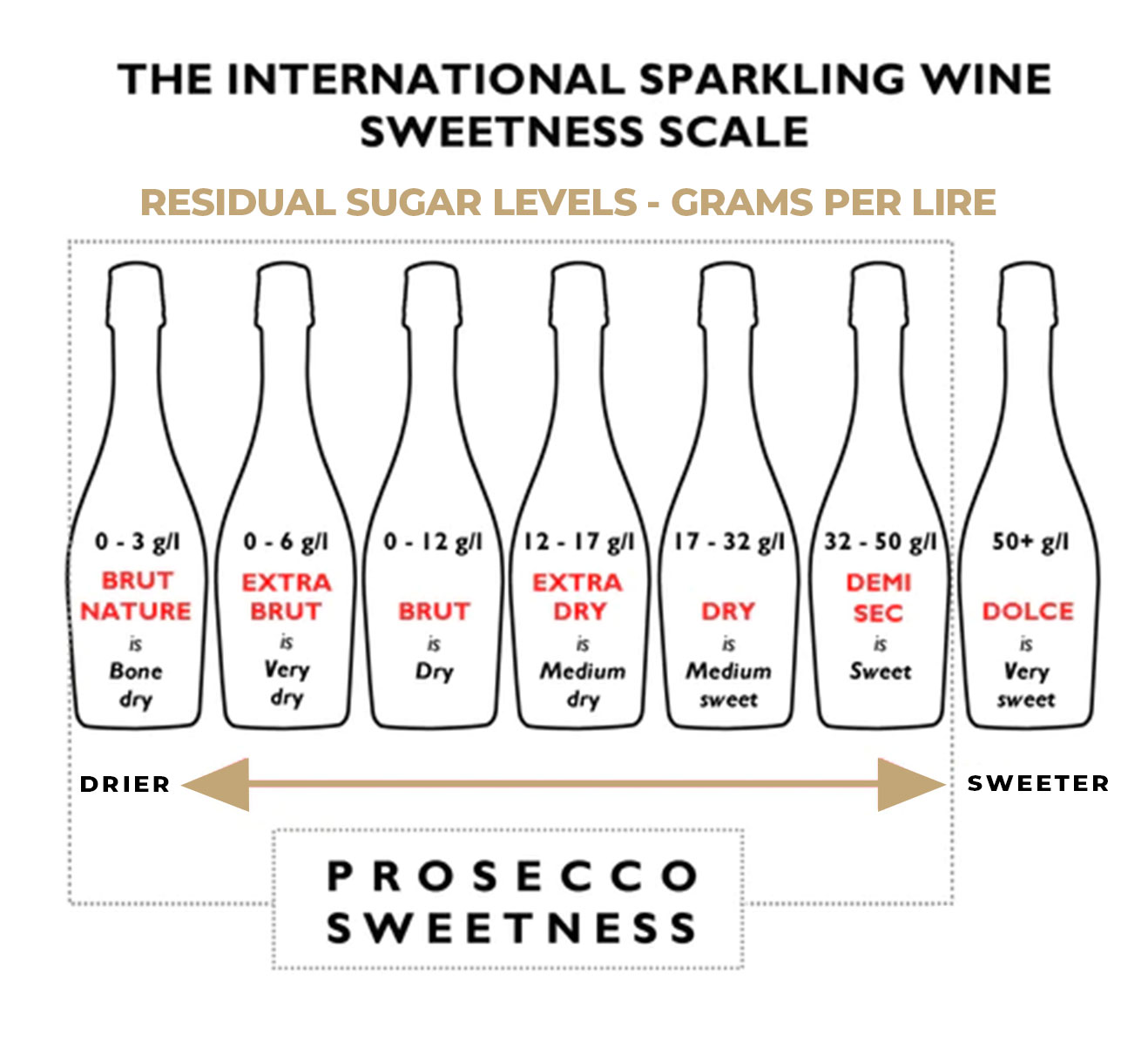
The diagram above highlights the names used to distinguish between which prosecco is dry, and which prosecco is sweet. Hopefully, this helps make things a little less confusing next time you look to buy.
Click Here for our HUGE Prosecco Sale (UP TO 58% OFF)
What's the Difference between Frizzante and Spumante?
Frizzante and Spumante are both terms used to describe different levels of carbonation in sparkling wines. Frizzante refers to a wine with a lower level of carbonation, resulting in a gentler and lighter effervescence. The bubbles in Frizzante wines are typically less intense and more delicate on the palate. On the other hand, Spumante indicates a higher level of carbonation, leading to a more vigorous and pronounced fizziness. The bubbles in Spumante wines are finer and more abundant, creating a livelier and more effervescent experience. Ultimately, the distinction lies in the intensity of the bubbles and the overall mouthfeel of the sparkling wine.
Champagne Production:
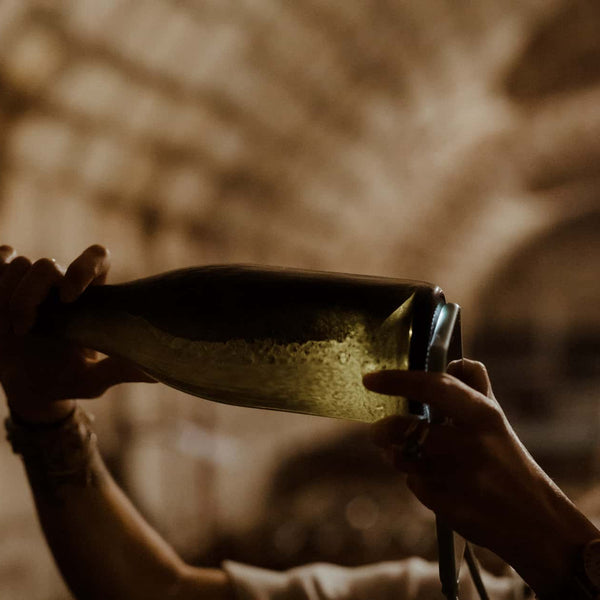
Champagne, often regarded as the pinnacle of sparkling wine, is crafted using the traditional method, also known as the méthode champenoise or méthode traditionnelle. Here's an overview of the steps involved:
Primary Fermentation: The process begins with the creation of a base wine, which is usually a blend of different grape varieties, primarily Chardonnay, Pinot Noir, and Pinot Meunier. Grapes are harvested and gently pressed to extract the juice.
Blending: After fermentation, different base wines from various vineyards and vintages are blended to achieve the desired flavor profile and consistency.
Bottling with Yeast and Sugar: A mixture of yeast and sugar, called the "liqueur de tirage," is added to the blended wine. This initiates a secondary fermentation within the bottle, where carbon dioxide is produced and trapped, creating bubbles.
Aging on Lees: The bottles are sealed with crown caps and stored horizontally in cool cellars to undergo aging on the lees (spent yeast cells). This aging process imparts complexity and depth to the wine.
Remuage (Riddling): Over time, the yeast sediment settles in the neck of the bottle. To remove this sediment, bottles are gradually rotated and tilted in a process known as remuage. This guides the sediment to the bottleneck.
Disgorgement: Once the sediment is concentrated in the neck, the bottleneck is frozen, and the crown cap is removed. The pressure in the bottle expels the frozen sediment plug, leaving behind a clear wine.
Dosage: To determine the wine's sweetness level, a mixture of wine and sugar (the "dosage") is added to the bottle. This step influences the final taste, with variations ranging from brut (dry) to doux (sweet).
Corking and Aging: The bottle is corked and wired to secure the cork. The wine is allowed to rest for several months or even years to harmonize flavors before being released to the market.
Prosecco Production:
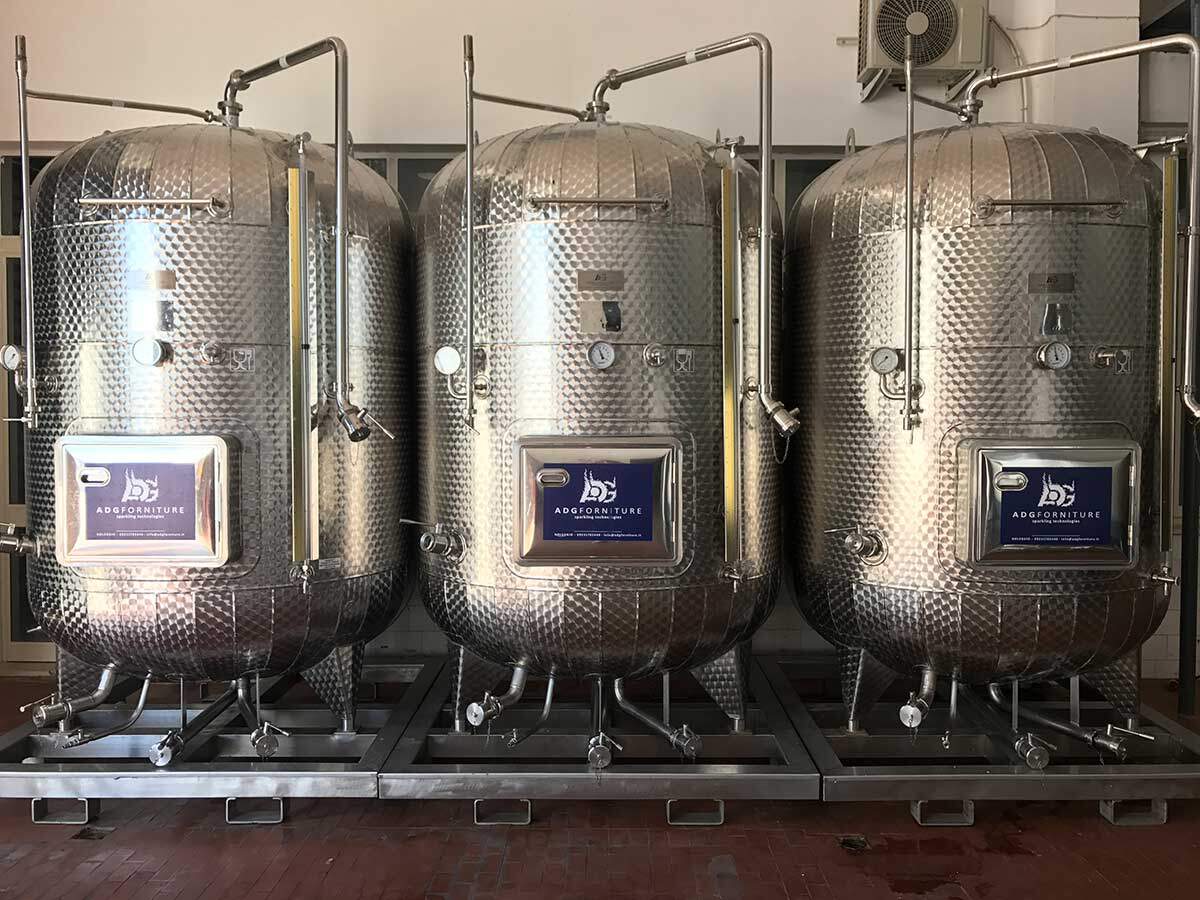
Prosecco is made using the Charmat method, also known as the Italian or tank method. This process emphasizes freshness and fruitiness, resulting in a lighter style of sparkling wine:
Primary Fermentation: Prosecco is typically made from the Glera grape variety. Grapes are harvested, gently pressed, and fermented to create a base wine.
Tank Fermentation: Unlike Champagne, where secondary fermentation occurs in individual bottles, in the Charmat method, secondary fermentation happens in large pressurized stainless steel tanks. The base wine is transferred to these tanks along with yeast and sugar.
Fermentation and Carbonation: The yeast consumes the added sugar, producing carbon dioxide, which dissolves into the wine, creating bubbles. The tank's controlled environment preserves the wine's fruitiness and floral notes.
Filtration and Bottling: Once the desired level of carbonation is achieved, the wine is filtered to remove the yeast and other solids. It's then bottled under pressure to retain its effervescence.
Closure: Prosecco bottles are sealed with a traditional cork or, more commonly, with a crown cap to maintain freshness and minimize oxidation.
Release: Prosecco is usually released relatively young and meant to be consumed within a couple of years to enjoy its vibrant, fruity character.
In summary, while both Champagne and Prosecco undergo secondary fermentation to achieve their bubbles, the methods, aging processes, and resulting flavor profiles differ significantly. Champagne's traditional method yields complexity and aging potential, while Prosecco's Charmat method emphasizes freshness and approachability.
What to Expect from a Prosecco:
Prosecco, known for its vibrant effervescence and approachable character, presents a delightful array of tasting notes that capture the essence of its origin and style. Here's what you might encounter when tasting a glass of Prosecco:
Aromas: Prosecco often greets the senses with crisp and refreshing aromas of green apple, pear, and citrus fruits, evoking a sense of vitality and brightness.
Bubbles: The hallmark of Prosecco is its lively and effervescent nature. Delicate bubbles create a playful and uplifting visual display in the glass.
Initial Taste: The first sip reveals flavors of fresh green apple and ripe pear, accompanied by subtle citrus undertones. The initial taste is typically light, crisp, and fruit-forward.
Floral Notes: Prosecco can sometimes exhibit floral nuances, with hints of white flowers like acacia or wisteria adding a touch of elegance to the palate.
Minerality: Depending on the specific terroir of the region, Prosecco may exhibit a mineral character, contributing a subtle layer of complexity to the wine.
Acidity: The wine's acidity lends a vibrant and refreshing quality, creating a balanced structure that keeps the palate engaged and invigorated.
Sweetness Levels: Prosecco comes in varying sweetness levels, from "Brut" (dry) to "Extra Dry" (slightly sweet). This range allows you to choose a style that suits your taste preferences.
Texture: Prosecco's texture is often light and lively, with a delicate mouthfeel that enhances its drinkability.
Finish: A well-crafted Prosecco typically finishes with a clean and crisp finale. The finish may leave behind a touch of fruitiness and a subtle hint of almonds.
Food Pairings: Prosecco's versatility makes it an excellent companion to a variety of dishes. It pairs well with appetizers, light seafood, salads, and dishes with tangy or creamy sauces.
Casual Elegance: Prosecco embodies a sense of casual elegance, making it suitable for a range of occasions from relaxed gatherings to celebratory moments.
What to expect from a Champagne:
Champagne is the epitome of sparkling elegance. Here are some common tasting notes you might experience when savoring a glass of Champagne:
Aromas: Champagne often begins with delicate aromas of green apple, citrus blossoms, and white peach, offering a fresh and inviting introduction.
Bubbles: Fine, persistent bubbles effervesce in the glass, tickling the senses and creating a lively visual display.
Initial Taste: On the first sip, you might encounter crisp and vibrant flavors of green apple, lemon zest, and hints of pear. The initial taste is often zesty and invigorating.
Mid-Palate: As you continue to sip, the wine's mid-palate might reveal more complex notes. Subtle hints of brioche, almond, and hazelnut can emerge, adding a layer of depth and richness.
Minerality: Champagne's terroir can influence its minerality. Chalky or flinty undertones may underscore the fruitiness, lending a unique character to the wine.
Acidity: Champagne is known for its bracing acidity, which lends a refreshing and cleansing sensation. This acidity enhances the wine's structure and balance.
Creaminess: If the Champagne has undergone extended aging on the lees (yeast sediment), you might experience a creamy, almost velvety texture that coats the palate.
Finish: A well-crafted Champagne typically finishes with finesse, leaving behind a lasting impression. The finish might be crisp and citrusy, with a touch of lingering sweetness or a gentle toastiness.
Complexity: Depending on the blend, aging, and production method, you might encounter layers of complexity that evolve with each sip. This complexity can make Champagne a wine to savor and contemplate.
Food Pairings: Champagne's versatility makes it an ideal pairing with various dishes. It complements a range of appetizers, seafood, poultry, and even richer dishes like foie gras, as well as desserts like fruit tarts.
Our Recommendations:
FodaFizz - Prosecco DOC Treviso 75cl - (CLICK HERE)
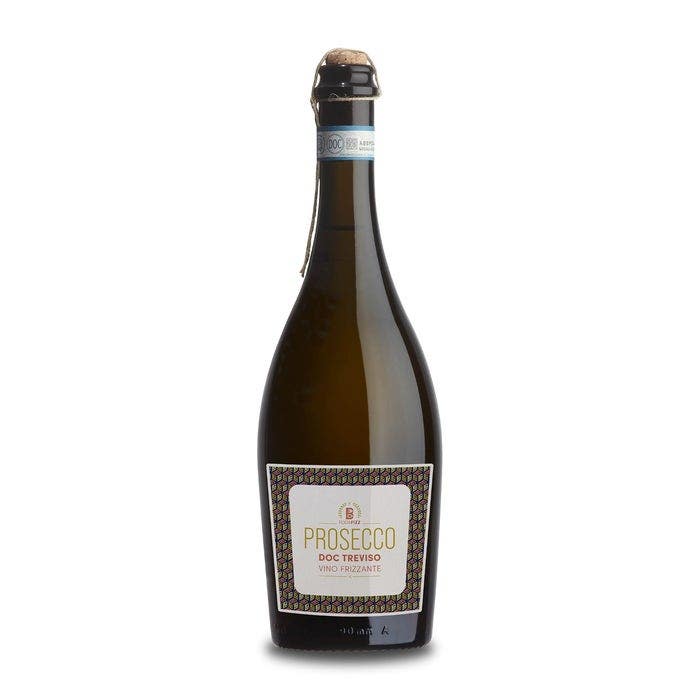
Produced in the very heart of the Treviso region of Italy, this Prosecco Frizzante has a gentle fizz, and very fine mousse delivering a light bright and easy drinking style. A delicious bouquet of golden apple and white flowers with a delicate almond note makes way to a crisp clean mouthfeel. Its softness makes it delicious as an aperitif, and perfect as an accompaniment for fish and shellfish dishes.
Champagne:
Gusbourne - Brut Reserve 2016 75cl
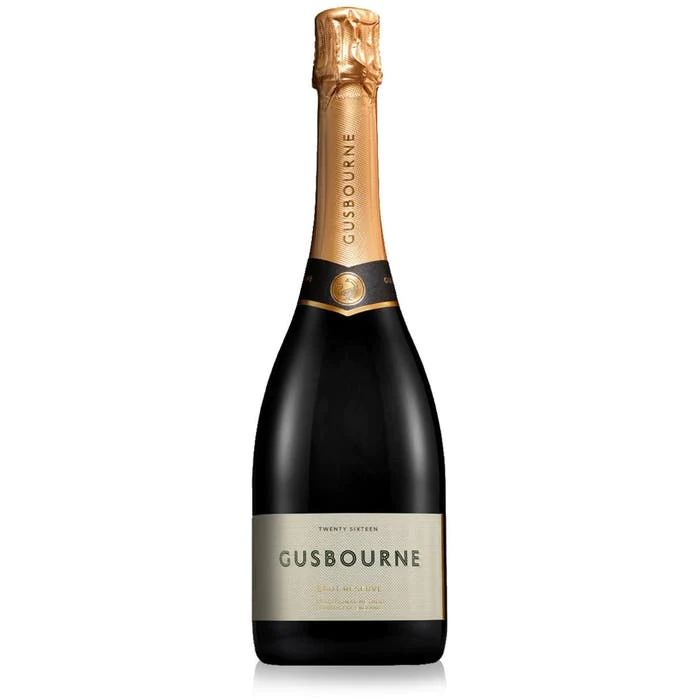
Bright gold in colour, this blend highlights red fruit aromas of cherry and strawberry, which then develop into attractive fresh pastry notes with a touch of cinnamon and spice. With a bright streak of citrus fruit, the palate is clean and fresh whilst giving tones of soft stone fruit and a long, refreshing finish.
